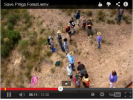Stop the Pilliga Forest coal seam gas mining
 Really informative video inside, beautifully put together by trevorjbc, containing a variety of knowledgeable speakers in the field, and showing the landscape. Farmers and environmentalists don't want CSG mining, but the government is likely to face a backlash from the minerals sector unless it acts. Critics fear that fracking not only opens up cracks in the coal seam, but could also result in gas escaping into drinking water as it rises to the surface. It would be economically reckless and short-sighted for the supply of CSG to destroy valuable farmland, and compromise underground water supplies. There are fears from some landholders that the ban in Victoria will be lifted. (This article has been adapted from a comment).
Really informative video inside, beautifully put together by trevorjbc, containing a variety of knowledgeable speakers in the field, and showing the landscape. Farmers and environmentalists don't want CSG mining, but the government is likely to face a backlash from the minerals sector unless it acts. Critics fear that fracking not only opens up cracks in the coal seam, but could also result in gas escaping into drinking water as it rises to the surface. It would be economically reckless and short-sighted for the supply of CSG to destroy valuable farmland, and compromise underground water supplies. There are fears from some landholders that the ban in Victoria will be lifted. (This article has been adapted from a comment).Coal seam gas is a fossil fuel that is almost entirely made up of the greenhouse gas, methane. It's feared that large tracts of farmland will become unavailable for food production, forests and native bushland will be cleared and fragmented.
According to the industry, developing new supplies is absolutely critical if Australia wants to put downward pressure on energy prices. However, the gas industry want to drill more and more wells to meet their lucrative export contracts, and our prices will be linked with the much higher Asian market.
If it comes to a choice of harvesting underground coal seam gas, until it expires, or the long term integrity of our land, food and water supplies, then it would be counter-productive to prioritise the former over the latter.
The Pilliga is a vast expanse of bushland, located between Narrabri and Coonabarabran in western NSW. This iconic area of public land is under threat from the largest coal seam gas project ever proposed for New South Wales.
The Wilderness Society has been most concerned about the possible impact on the Pilliga forest and Channel Country region of Queensland's Cooper Basin. The government is prepared to relax environmental laws, or "green tape", for gas exploration.
Pilliga forest home to many threatened species, including the koala, Pilliga mouse, superb parrot and southeastern long-eared bat and regent honeyeater. A new ecological study of the Pilliga Forest in north-west NSW has found it is a “Noah's Ark” or refuge for many bird and mammal species that are declining across Australia.
Santos says it believes its CSG operations in the Pilliga can supply 25 per cent of the state's gas needs. More than 54% of Australia is covered by coal and gas licences or applications, and its clear that mining companies are riding roughshod over our governments and local communities. Dead animal bones in the bottom of a coal seam gas wastewater pond, according to the Stop Pilliga Coal Seam Gas movement,
The NSW government gave approval for the drilling in the woodlands in eastern Australia under stringent environmental conditions. The NSW government is hoping that a successful development by Santos of its coal-seam gas development in the Pilliga Forest in the northwest of the state will both satisfy some of the state's energy needs and demonstrate that coal-seam gas is not as environmentally harmful as its opponents claim.

Recent comments